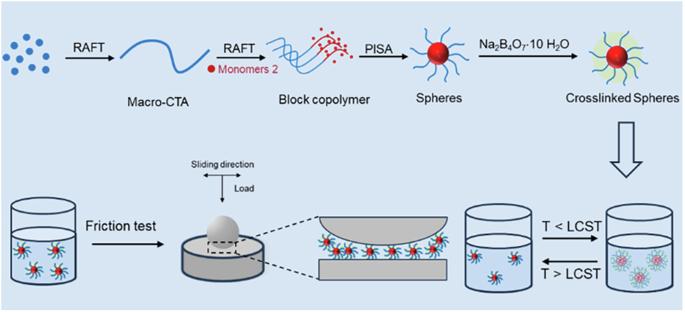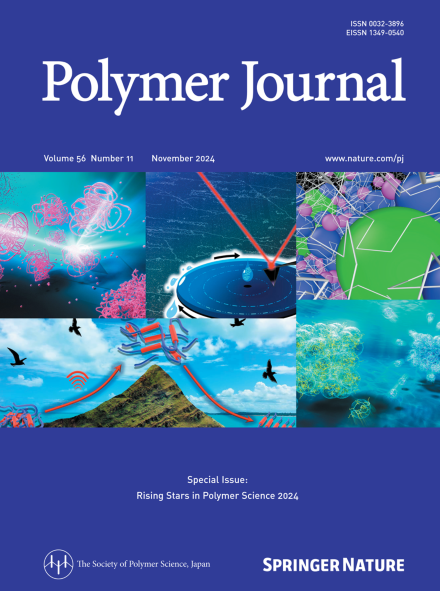Polymerization-induced self-assembly of thermoresponsive micelles and their lubrication adaptivity
IF 2.7
4区 化学
Q3 POLYMER SCIENCE
引用次数: 0
Abstract
Responsive materials have significant application value because of their ability to actively adjust their structure or properties in response to external stimuli. Poly(N-isopropylacrylamide) (PNIPAM) is widely used to form micelles, particularly for drug delivery, because its lower critical solution temperature (LCST) is close to body temperature. However, the preparation of micelles based on PNIPAM block copolymers often involves complex processes, which limit their broader application. Here, we employed polymerization-induced self-assembly (PISA) combined with in situ crosslinking to synthesize stabilized thermoresponsive micelles, such as poly(glycerol methacrylate)-b-poly(N-isopropylacrylamide)-B (PGMAx-b-PNIPAMy-B), which are spherical micelles with a thermoresponsive core of PNIPAM and a crosslinked shell of PGMA formed by sodium tetraborate decahydrate. The micelles exhibited rapid and reversible self-assembly and collapsed at 31 °C, enabling temperature regulation through light transmittance, which makes them suitable for smart window applications. Furthermore, these micelles demonstrated excellent friction-reducing and wear-resistant properties at various temperatures (25–36 °C) and under various loads (20–70 N), indicating their adaptive lubrication as additives. This work presents the facile fabrication of thermoresponsive micelles and expands the application of PISA technology in the tribological field. Responsive materials have significant application value because of their ability to actively adjust their structure or properties in response to external stimuli. We employed polymerization-induced self-assembly combined with in situ crosslinking to synthesize stabilized thermoresponsive micelles, such as poly(glycerol methacrylate)-b-poly(N-isopropylacrylamide)-B, which exhibited rapid and reversible self-assembly. Furthermore, these micelles demonstrated excellent friction-reducing and wear-resistant properties showcasing their adaptive lubrication as additives. This work presents the facile fabrication of thermoresponsive micelles and expands the application of PISA technology in the tribological field.

聚合诱导热响应胶束的自组装及其润滑适应性
响应性材料具有重要的应用价值,因为它们具有响应外部刺激主动调整其结构或性能的能力。聚n -异丙基丙烯酰胺(PNIPAM)被广泛用于形成胶束,特别是用于药物输送,因为它的较低临界溶液温度(LCST)接近体温。然而,基于PNIPAM嵌段共聚物的胶束制备通常涉及复杂的工艺,这限制了其更广泛的应用。在这里,我们采用聚合诱导自组装(PISA)结合原位交联来合成稳定的热响应胶束,如聚(甲基丙烯酸甘油)-B -聚(n-异丙基丙烯酰胺)-B (PGMAx-b-PNIPAMy-B),这是一种球形胶束,具有PNIPAM的热响应核和由十水四硼酸钠形成的PGMA的交联壳。胶束表现出快速和可逆的自组装,并在31°C下崩溃,通过透光率实现温度调节,这使得它们适合智能窗口应用。此外,这些胶束在不同温度(25-36°C)和不同载荷(20-70 N)下表现出优异的减摩和耐磨性能,表明它们作为添加剂具有自适应润滑作用。本工作展示了热响应胶束的简易制备,扩展了PISA技术在摩擦学领域的应用。响应性材料具有重要的应用价值,因为它们具有响应外部刺激主动调整其结构或性能的能力。我们采用聚合诱导自组装与原位交联相结合的方法合成了稳定的热响应胶束,如聚(甲基丙烯酸甘油)-B -聚(n-异丙基丙烯酰胺)-B,它具有快速可逆的自组装特性。此外,这些胶束表现出优异的减摩和耐磨性能,展示了它们作为添加剂的自适应润滑性能。本工作展示了热响应胶束的简易制备,扩展了PISA技术在摩擦学领域的应用。
本文章由计算机程序翻译,如有差异,请以英文原文为准。
求助全文
约1分钟内获得全文
求助全文
来源期刊

Polymer Journal
化学-高分子科学
CiteScore
5.60
自引率
7.10%
发文量
131
审稿时长
2.5 months
期刊介绍:
Polymer Journal promotes research from all aspects of polymer science from anywhere in the world and aims to provide an integrated platform for scientific communication that assists the advancement of polymer science and related fields. The journal publishes Original Articles, Notes, Short Communications and Reviews.
Subject areas and topics of particular interest within the journal''s scope include, but are not limited to, those listed below:
Polymer synthesis and reactions
Polymer structures
Physical properties of polymers
Polymer surface and interfaces
Functional polymers
Supramolecular polymers
Self-assembled materials
Biopolymers and bio-related polymer materials
Polymer engineering.
 求助内容:
求助内容: 应助结果提醒方式:
应助结果提醒方式:


